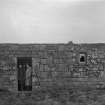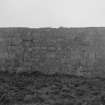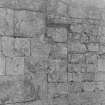Field Visit
Date 3 June 1925
Event ID 1099392
Category Recording
Type Field Visit
Permalink http://canmore.org.uk/event/1099392
St. Serf's Priory.
On the largest island on Loch Leven, a low sandy flat of some 80 acres not far from the southern shore, are remains, which the masonry and details prove to represent the oblong chamber of a 12th century church, measuring 27 by 19 ¼ feet over walls 2 ½ feet thick. The older masonry is of thinly jointed ashlar, fairly cubical, laid in 14-inch courses with occasional stones set against the bed; a double footing returns on three sides, the northern side having a single footing only. There are traces of an archway in each end wall. Of these the one on the east gave access to a chancel, which excavation (1) has proved to have been rectangular, with an internal width of 9 feet and a length of 13 feet 6 inches. The one on the west opened to either a tower or a nave, a feature which was possibly an afterthought. This latter arch, 6 ½ feet wide, has a hollow-chamfered impost not unlike a common Saxon form. In the south wall are a small lintelled window, a niche with simple arch-head, a benatura, and a lintelled doorway, all of which are secondary. The building has been converted into a fishing hut or bothy; where old masonry has been re-used, it is indicated on the plan by a cross-hatch.
About 25 yards westward of the church are the foundations of a large rectangular structure, measuring 83 feet 2 inches by 22 feet 8 inches within walls over 5 feet in thickness. Its character is indeterminate.
Excavation revealed burials south and west of the chapel, while within the chancel, which had been divided into four compartments by thin stone walls, there were found nine complete skeletons (1).
HISTORICAL NOTE.- Brude, the last king of the Picts (d. 843) is said to have given the island of Lochleven to God and Saint Serf and the hermit Culdees dwelling and serving God there. Thereafter the Culdees granted their ground to Fothath, Bishop of St. Andrews, in return for the provision of food and clothing, Ronan being then "monk and abbot." This transaction is to be dated about 950 A.D. At a later date Macbeth and Gruoch, "King and Queen of Scots" granted Kirkness to the Culdees of the island; Maldunus, Bishop of St. Andrews, gave them the church of Markinch; Tuadal, the church of "Sconyn " (Scoonie) on the westside of Largo Bay; Queen Margaret the "vill" of Balcristie, in the parish of Newburn, which is to be interpreted as an annual rent; Modach (?Fothath), bishop of St. Andrews, the church of "Hurkenedorath"; Ethelred, son of Malcolm and Margaret, Ardmore (now Auchmoor) at the east end of Loch Leven; and King Edgar (1097-1107) "Petnemokane" near Kirkness. About 1150 King David granted the island to the canons of St. Andrews that they might establish the canonical order there and expel those Culdees who should refuse to conform (2). Two or three years later, Bishop Robert conferred the "Abbey"* on the Priory of St. Andrews (3). The grant included sixteen books, four of them service-books, which formed the library of the island Priory. The existing building is probably later than these transactions. In and after 1395 the prior of St. Serf's was Andrew of Wyntoun, author of The Orygynale Cronykil of Scotland, which was probably written within the Priory.
RCAHMS 1933, visited 3 June 1925.
(1) Proc. Soc. Ant. Scot., xvi (1881-2), pp.159-68. (2) Liber Cartarum Prior. S. Andree (Bannatyne Club), passim. The grants specified are recorded in Notitia. (3) Ibid. Cf. Lawrie's Early Scottish. Charter's, p. 446.
* 'Abbatiam' in the general sense of 'monastery.' St. Serf's was strictly a priory.











